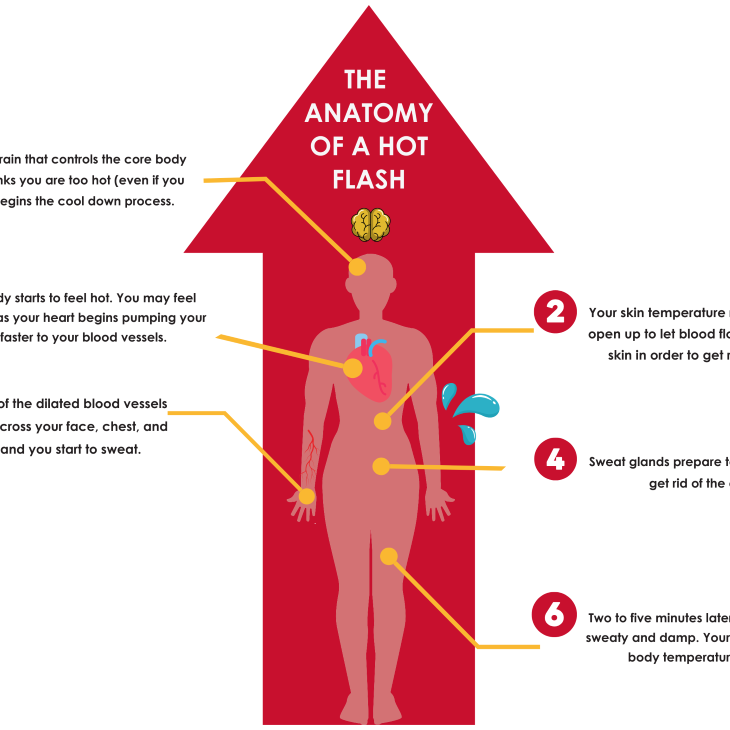
Is it Menopause?
Usually sometime in your 40s, you will begin the transition from your reproductive years to menopause. The length of your cycles will start to vary and you’ll begin to skip periods. You may experience hot flashes due to decreased estrogen production by your ovaries and may have difficulty sleeping. Pregnancy is rare but not impossible, so contraception is still needed to avoid pregnancy.
WHAT IS THE MENOPAUSAL TRANSITION?
The menopausal transition (perimenopause) is the period that links a woman’s reproductive (childbearing) years and menopause. A woman is said to be in menopause if she has had no menstrual periods for 1 year. Once in menopause, the ovaries essentially stop making hormones and women lose their ability to become pregnant. The average age for menopause is 51 years.During the menopause transition, women often have changing menstrual cycles, vaginal dryness, hot flashes or flushes (sudden sense of heat and flushing of face and chest with sweating and sometimes chills), and problems with sleep. Some of these symptoms happen all the time while others come and go. Symptoms can be mild to unbearable and can interfere with daily activities and sleep. Perimenopause is different for each woman but usually lasts about 5 years. Watch the Comprehensive Perimenopause Video (26 mins)
WHAT HORMONAL CHANGES OCCUR DURING THE MENOPAUSAL TRANSITION?
Many of the symptoms a woman notices during the transition are due to changing hormone levels. These shifts can cause changes in the menstrual cycle and sleep, as well as hot flashes and vaginal dryness. Hormones work together to keep a balance. As hormone levels go up or down, they trigger the ovaries or pituitary gland in the brain to make more or less of other hormones. As a woman gets older, the hormonal balance changes. The following hormones play a role in the menopausal transition.
 Inhibin
Inhibin
One of the first hormonal changes is a decrease in a hormone called inhibin. The ovary makes inhibin and it tells the pituitary gland to make less follicle-stimulating hormone (FSH). As inhibin levels go down, FSH levels go up. The changes in blood levels of these hormones can be found months to years before a woman begins the transition to menopause.
 FSH
FSH
FSH is made by the pituitary gland. Levels often go up and down during the menopause transition. FSH levels can be very high one day and very low the next day. When FSH levels are high, the ovaries make more estrogen. When FSH levels drop, estrogen levels drop. These changes in FSH and estrogen can happen months to years before menopause.
 Progesterone
Progesterone
Progesterone is made by the ovary and increases after ovulation (release of an egg from the ovary). As a woman ovulates less often, progesterone levels may remain low, causing a missed menstrual period.
 AMH
AMH
Antimüllerian hormone (AMH), like inhibin, is made by the ovaries. As a woman ages, her AMH levels drop and are not detectable a few years before she enters menopause.
It is important to understand that hormonal changes vary from woman to woman. While high FSH and low AMH and inhibin levels are often seen in the menopause transition, there is no one specific blood test that can predict or diagnose that a woman is in the menopause transition.

WHAT SYMPTOMS AM I MOST LIKELY TO EXPERIENCE?
Click here to View the Hot Flash Infographic
Symptoms vary greatly from woman to woman. They may occur at different times and with different degrees of severity. The information below is meant only as a guide about what you may experience, and does not cover all possible symptoms.
Change in menstrual bleeding patterns:
As women age, menstrual periods change. They may be more or less frequent, shorter or longer, and heavier or lighter. It is important to know that ovulation can still occur, and women in perimenopause can sometimes get pregnant. Women who do not wish to get pregnant should continue to use birth control until they have not had a menstrual period for 12 months.
Changes in a woman’s menstrual cycle are common and expected during perimenopause. However, worsening bleeding or irregular bleeding should be discussed with a health-care provider. Abnormal bleeding may be the result of other problems with the uterus, such as polyps, fibroids, hyperplasia (overgrowth of the lining of the uterus), or even cancer.
Hot flashes and vaginal symptoms (for example, dryness, itching, and painful sex):
These symptoms are usually caused by low estrogen levels, and may start months to years before the menopause transition. Although approximately two out of three women will have hot flashes at some point, the timing, amount, and length of these symptoms can vary. Hot flashes can last from months to a few years. For most women, these symptoms gradually get better. Vaginal symptoms can increase over time. Vaginal dryness may be especially noticeable during sex. It is important to tell your doctor about bothersome changes so that they can be properly managed.
Mood symptoms/sleep disturbances:
During perimenopause, some women also have problems with sleeping, forgetfulness, and depression/anxiety. Decrease in sex drive (libido) is also quite common. While many of these symptoms can be a result of dropping estrogen levels, they may also be a sign of other medical conditions. If you experience any of these symptoms, please talk to your doctor to get the proper care.
WHAT TREATMENTS ARE THERE FOR SYMPTOMS OF PERIMENOPAUSE?
Bleeding problems:
Before treatment is started, you should have a thorough check-up. If the abnormal bleeding is due to the hormonal changes of perimenopause, treatment can be started with estrogen and/or progesterone in the form of pills, shots, patches, or intrauterine device (IUD).
Hot flashes:
Taking estrogen as pills, patches, gels, or sprays is very helpful in relieving hot flashes. Women who have a uterus should also take medications that protect against precancerous changes in the lining of the uterus that can come from the long-term use of estrogen alone. For some women, herbal medicines or acupuncture may help a little, but there is not much medical evidence that these work for all women. Finally, some medicines (antidepressants and central nervous system medicines) that are typically used for other reasons can also relieve hot flashes. They may also help women who have problems with their sleep or mood. Lifestyle changes, such as avoiding caffeine and alcohol, keeping the environment cool, and wearing lighter clothing, may reduce symptoms. Be sure to talk to your doctor about whether hormone therapy is the right choice for you.
Vaginal symptoms:
Women often find relief for vaginal dryness and discomfort by using hormone medication (as a pill, patch, gel, cream, or spray). Vaginal moisturizers or lubricants can also help. Please be sure to talk to your doctor about any vaginal symptoms. These symptoms are some of the easiest to successfully treat and have the fewest side effects.
Vaginal dryness may begin before the onset of menopause
Vaginal dryness and discomfort is a common symptom of reproductive aging but unfortunately is one that women often do not complain of unless asked about.Of all the symptoms that women experience with aging and menopause, vaginal dryness is one that can be most successfully treated with few treatment-related risks. A number of products are available, such as over the counter agents that include lubricants and moisturizers, a variety of vaginal estrogen products that have minimal absorption into the bloodstream, and oral or transdermal (across the skin) hormone options, to help address the problem of vaginal dryness.
View the Menopause Video (18 mins) to find out moreFIND AN EXPERT

Fact Sheets and Booklets
ASRM has publications written with you in mind that go in depth on what to expect as you age.
Age and Fertility (booklet)
Generally, reproductive potential decreases as women get older, and fertility can be expected to end 5 to 10 years before menopause.
Menopausal Transition (Perimenopause): What Is It?
The menopausal transition (perimenopause) is the period that links a woman’s reproductive (childbearing) years and menopause.
Osteoporosis
Osteoporosis and osteopenia are conditions of having low bone mass (density).














